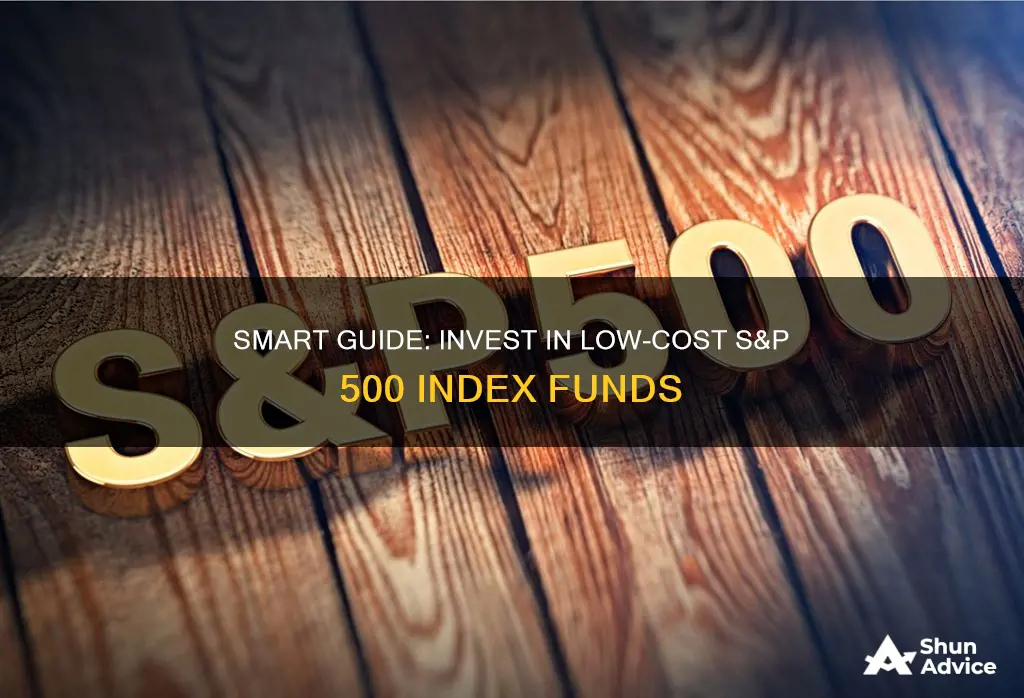
The S&P 500 is a stock market index composed of about 500 large public U.S. companies. It is widely considered a proxy for the overall health of the U.S. stock market. An index fund is a type of investment fund that is based on an index and aims to mirror its performance. An S&P 500 index fund, therefore, allows investors to gain exposure to the performance of the S&P 500 without having to purchase the individual stock of each company.
S&P 500 index funds are popular because they offer instant diversification, broad exposure to some of the biggest companies in the U.S., and are generally considered less risky than purchasing individual stocks directly. They are also passively managed, which results in lower fees compared to actively managed funds.
When choosing an S&P 500 index fund to invest in, it is important to consider the fund's expense ratio, minimum investment, dividend yield, and inception date. Some of the most popular S&P 500 index funds include the Vanguard 500 Index Admiral Fund, Fidelity 500 Index, and Schwab S&P 500 Index Fund.
To invest in an S&P 500 index fund, you will need to open a brokerage account, such as a taxable brokerage account, an individual retirement account (IRA), or a 401(k). You can then use this account to purchase the desired index fund, and some brokers even allow you to set up recurring investments.
| Characteristics | Values |
|---|---|
| Investment options | S&P 500 Index Funds, S&P 500 ETFs, Individual stocks |
| Investment accounts | Brokerage account, Individual Retirement Account (IRA), 401(k) |
| Investment strategies | ETFs, Index funds, Individual stocks |
| Investment timing | Long-term, Short-term |
| Investment costs | Expense ratios, Sales load, Commissions, Share price |
| Investment diversification | Large-cap, Mid-cap, Small-cap, Domestic, International, Bonds |
| Investment performance | Average annual return of 10% |
What You'll Learn

Choosing an S&P 500 index fund
When choosing an S&P 500 index fund, there are a few key factors to consider.
Firstly, look at the expense ratio, which represents the fees you pay for the fund's upkeep. As index funds are passively managed, these fees should be relatively low, and with all S&P 500 index funds performing similarly, the amount you pay in fees becomes a crucial differentiator when selecting a fund. For example, the Vanguard 500 Index Admiral Fund (VFIAX) has an expense ratio of 0.04%.
Secondly, consider the minimum investment required. Index funds have different minimums for taxable investment accounts and IRAs, so ensure your chosen fund aligns with the amount you have to invest initially and that you can purchase additional shares in intervals that suit your budget. For instance, Vanguard's VFIAX fund has a minimum investment of $3,000, while the Fidelity 500 Index Fund (FXAIX) has no minimum investment.
Thirdly, compare the dividend yield between funds, as dividends can boost returns even in down markets.
Finally, if you prefer to see a track record of a fund's performance, pay attention to its inception date. A longer history will show how the fund has capitalized on bull markets and mitigated losses in bear markets.
It's worth noting that you only need one S&P 500 index fund in your portfolio, as they post broadly similar returns, and there is little to gain by splitting your assets between multiple funds.
Selling Investment Funds: Knowing When to Let Go
You may want to see also

Opening an investment account
If you don't already have a brokerage account, you'll need to open one to buy investments. You can use the money you deposit into the brokerage account to purchase S&P 500 stocks or funds, which will then be held within that account.
- Determine your investment goals: Before opening an investment account, it is important to understand your financial goals and risk tolerance. Are you investing for retirement, saving for a down payment on a house, or simply looking to grow your wealth over time? Different investment accounts may be more suitable for different goals.
- Compare brokerage firms: Not all brokerage firms are created equal. Compare fees, account minimums, investment options, and other features to find a firm that aligns with your needs and goals.
- Gather the required information: To open an investment account, you will typically need to provide personal information such as your name, date of birth, Social Security number, and contact information. You may also need to provide financial information, such as your annual income and net worth.
- Complete the account application: Visit the website of your chosen brokerage firm and fill out the application for the type of account you want to open. Follow the instructions carefully and provide all the required information.
- Fund your account: Once your account is approved, you will need to fund it before you can start investing. You can typically fund your account by linking a bank account and transferring money electronically. Some firms may also allow you to fund your account by check or wire transfer.
- Choose your investments: Once your account is funded, you can start investing in the S&P 500. Research and compare different S&P 500 index funds or ETFs to find those that align with your investment goals and risk tolerance. Consider factors such as fees, performance, and the fund's track record.
- Place your trades: Once you have decided on the specific S&P 500 investments you want to make, use your brokerage account to place your trades. You can typically do this through the broker's website or trading platform. Specify the number of shares or the dollar amount you want to invest.
- Monitor and adjust your portfolio: Once you have made your investments, it is important to regularly review and monitor your portfolio's performance. The S&P 500 is a broad index, so it is important to ensure that your portfolio remains diversified. Rebalance your holdings if necessary to maintain your desired asset allocation.
Best Fidelity Funds to Maximize Your 401(k) Returns
You may want to see also

Buying the index fund
The S&P 500 is a well-known stock market index. It is not an investment itself, but a list of companies that are related in some way or otherwise grouped together. You can't directly invest in a stock market index like the S&P 500, but you can invest in an index fund or exchange-traded fund (ETF) that tracks the index.
An S&P 500 index fund or ETF is the simplest way to invest in the index. These funds aim to replicate the returns of the S&P 500 by tracking it, offering investors exposure to S&P 500 companies without the effort involved in purchasing the individual stock of each company.
You can purchase index funds and ETFs in a taxable brokerage account, or if you're investing for retirement, in a 401(k) or IRA, which come with added tax benefits.
Opening an investment account
If you don't already have a brokerage account, you'll need to open one to buy investments. You can use the money you deposit into the brokerage account to purchase S&P 500 stocks or funds, which will then be held within that account.
If your ultimate goal is investing for retirement, consider investing in the S&P 500 through a 401(k) or IRA, rather than a taxable brokerage account.
Choosing an S&P 500 index fund
There are many S&P 500 index funds available in the market, so it's important to keep a few criteria in mind when picking the right one for your portfolio.
- Expense ratio: As index funds are passively managed, expense ratios, which represent the fees you pay for the upkeep of your fund, should be nominal. Because all S&P 500 index funds perform very similarly, the amount you're paying in fees becomes incredibly important when picking a fund.
- Minimum investment: Index funds have different investment minimums for taxable investment accounts and IRAs. Make sure your favourites align with the initial amount you have to invest and that you'll be able to purchase more shares in intervals that work with your budget.
- Dividend yield: Dividends can be one of the perks of investing in large-cap companies. Be sure to compare the dividend yield between index funds as dividends could boost returns, even in down markets.
- Inception date: If you're an investor who prefers to see a solid track record for a fund prior to investment, pay attention to the fund's inception date. Funds with longer histories can help you see how an index fund capitalized on bull markets and mitigated losses in bear markets.
Once you know the S&P index fund you want to buy and how much you're able to invest, go to your broker's website and set up the trade.
Stick to the broker's easy trade entry form, which often appears at the bottom of the screen. Input the fund's ticker symbol and how many shares you'd like to buy, based on how much money you've put into the account.
If you're able to move money into the brokerage account regularly, many brokers allow you to set up an investing schedule to buy an index fund on a recurring basis. This is a great option for investors who don't want to remember to place a regular trade. You can set it and forget it.
As a result, you'll be able to take advantage of the benefits of dollar-cost averaging, which can help you reduce risk and increase your returns.
Vanguard Funds: Ethical Investing and Weapons Manufacturers
You may want to see also

Monitoring and rebalancing investments
Monitoring and rebalancing your investments is an important part of investing in the S&P 500. Here's what you need to know:
Monitoring Your Investments
It's important to periodically review your S&P 500 investments to ensure they are performing as expected and are aligned with your financial goals. Here are some key aspects to monitor:
- Performance: Review the performance of your S&P 500 investments by analysing returns over different periods. Compare this with the broader market and other similar funds to assess how your investments are doing.
- Dividends: Dividends are a significant component of investing in the S&P 500, as the large-cap companies in the index often pay dividends. Monitor the dividend yield of your investments and compare it with other funds to ensure you're getting competitive returns.
- Asset Allocation: Keep an eye on your asset allocation, especially if you have multiple investments. Ensure that your portfolio remains diversified and make adjustments if certain investments start to dominate your portfolio.
- News and Announcements: Stay informed about news and announcements related to the companies in the S&P 500. This can include earnings reports, mergers, acquisitions, or other events that may impact the performance of your investments.
- Economic and Market Conditions: Monitor broader economic and market trends, as these can impact the performance of the S&P 500. Keep an eye on interest rates, inflation, and sector-specific developments that may affect your investments.
Rebalancing Your Investments
Rebalancing involves adjusting your portfolio to maintain your desired asset allocation and ensure it remains aligned with your financial goals. Here are some key considerations for rebalancing:
- Frequency: Determine how often you want to rebalance your portfolio. This could be done annually, semi-annually, or when your asset allocation deviates from your desired allocation by a certain threshold (e.g., 5-10%).
- Buy and Sell Decisions: When rebalancing, decide which investments to buy more of and which to reduce. This typically involves buying more of the investments that have performed well and selling some of the investments that have underperformed, bringing them back in line with your desired allocation.
- Tax Implications: Be mindful of the tax implications of rebalancing. Selling investments that have appreciated significantly may trigger capital gains taxes. Consider strategies like tax-loss harvesting to offset these taxes.
- Risk and Return: Assess the risk and return characteristics of your investments during the rebalancing process. Ensure that the rebalanced portfolio aligns with your risk tolerance and expected returns.
- Long-Term Goals: Keep your long-term financial goals in mind when rebalancing. Ensure that your rebalanced portfolio supports your goals, such as retirement planning, saving for a down payment on a house, or other objectives.
By regularly monitoring and rebalancing your S&P 500 investments, you can stay on track to meet your financial goals while managing risk and optimising returns. Remember to consider your personal circumstances and seek professional advice when making investment decisions.
Mutual Fund Investing: What You Need to Know
You may want to see also

Differences between index funds and ETFs
Index funds and exchange-traded funds (ETFs) have a lot in common. Both are passive investment vehicles that pool investors' money into a basket of securities to track a market index. They are also low-cost ways for individuals to gain broad market exposure. However, there are some key differences between the two that investors should understand.
Fees and Expenses
The primary difference between ETFs and index funds is how they're bought and sold. ETFs trade on an exchange just like stocks, and you buy or sell them through a broker. Index funds are bought directly from the fund manager.
Because ETFs are bought and sold on an exchange, you will pay a commission to your broker each time you make a trade. That said, some brokers offer commission-free trading.
ETFs generally have a slight advantage when it comes to annual expense ratios -- the percentage of assets you'll pay for managing the fund. But the difference between expense ratios for widely traded ETFs and index funds has narrowed in recent years.
Minimum Investments
You can invest in an ETF by buying as little as one share. In contrast, index funds often have a minimum investment requirement, which can be a barrier for some investors.
Taxes
ETFs are more tax-efficient than index funds by nature, thanks to the way they’re structured. When you sell an ETF, you’re typically selling it to another investor who’s buying it, and the cash is coming directly from them.
To get cash out of an index fund, the fund manager will have to sell securities to generate the cash to pay to you. When this sale is for a gain, the net gains are passed on to every investor with shares in the fund, meaning you could owe capital gains taxes without ever selling a single share.
Liquidity
Liquidity is the ease with which an investment can be bought or sold for cash. ETFs are bought and sold like stocks, meaning you can buy or sell them anytime the stock market is open.
Index fund transactions, on the other hand, are cleared in bulk after the market closes. So if you put in an order to sell shares of an index fund at noon, the transaction will actually take place hours later at a price equal to the value of the fund at market close.
Trading Flexibility
The significant difference between index funds and ETFs is how you buy shares in them and their flexibility. Index mutual funds can only be bought and sold at the end of the trading day, based on the fund's net asset value (NAV). ETFs trade throughout the day on a stock exchange, just like stocks, and their price fluctuates based on supply and demand.
Best Index Funds to Invest in: A NerdWallet Guide
You may want to see also
Frequently asked questions
The S&P 500 is a stock market index composed of about 500 large public U.S. companies. It is considered a proxy for the overall health of the U.S. stock market.
You can invest in the S&P 500 by buying an S&P 500 index fund or exchange-traded fund (ETF). These funds aim to replicate the returns of the S&P 500 by tracking it, offering investors exposure to the index's companies without the effort of purchasing individual stocks.
Investing in an S&P 500 index fund or ETF can instantly diversify your portfolio and is generally considered less risky than purchasing individual stocks directly. The S&P 500 has historically returned about 10% per year on average, making it a solid investment option for long-term gains.
Here are some popular S&P 500 index funds with low expense ratios:
- Vanguard 500 Index Fund Admiral Shares (VFIAX)
- Schwab S&P 500 Index Fund (SWPPX)
- Fidelity Zero Large Cap Index (FNILX)
- Fidelity 500 Index Fund (FXAIX)
- T. Rowe Price Equity Index 500 Fund (PREIX)







